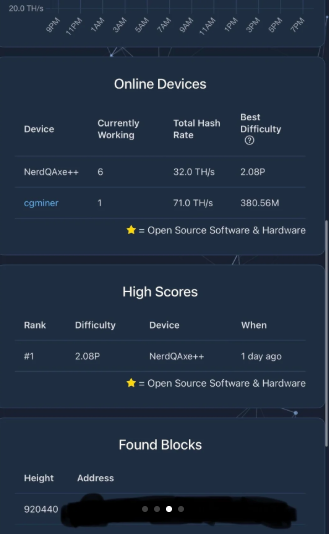-
He used six NerdAxe++ miners and one Avalon Q, all home miners.
-
Their share represented a tiny fraction of Bitcoin’s total computing power.
The echoes of the lone miner who won the Bitcoin lottery continue to resonate.
Yesterday, October 25, a Reddit user published the details of his small installation to mine Bitcoin individually, with which he managed to process a complete block and obtain a total reward of more than $340,000.
This is a case of solo mining, a modality in which a person or entity seeks to discover a block on his ownwithout sharing profits with a mining group or pool.
As NoticiasVE explained, the miner used six mini ASICs NerdAxe++an ASIC miner model designed to operate from home, and an Avalon Q, the equipment developed by the Canaan company for home environments. Both models were reported by NoticiasVE in their respective releases.
So how much hashrate did this miner contribute and how much does it represent in the total Bitcoin network?
In total, the seven teams achieved a hash rate (the unit that measures computing power in the Bitcoin network) of around 100 terahashes per second (TH/s).
According to the publication, the NerdAxe++ together contributed about 32 TH/s (about 5 TH/s each), while the Avalon Q contributed an additional 71 TH/s, as seen in the following image:

To measure that figure, it is enough to compare those 100 TH/s with the total computing power of the Bitcoin network, which currently amounts to 1.16 zettahashes per second (ZH/s).
In numerical terms, 1 ZH/s is equivalent to one trillion (1,000,000,000,000) TH/s. This means that the lone miner It contributed just 0.000000000086% of Bitcoin’s total processing power.
The 100 TH/s capacity can also be compared with industrial equipment. For example, the Bitmain Antminer S19 XP Hydro, launched in October 2022 and an almost obsolete miner, offers 257 TH/s, more than double what the lone miner used.
On the other hand, the Bitmain Antminer S21E XP Hyd 3U, presented in November 2024 and at the time of this writing the most profitable equipment for Bitcoin mining according to Whattomine, reaches 860 TH/s, that is, almost nine times more power than the Reddit user’s entire home installation.
What must also be considered is that these industrial ASICs are used by industrial farms and mining pools, but in large quantities, hundreds or thousandswhile “the Reddit miner” only used 7 devices and all of them were home devices with low computing power.
According to the miner himself, «a little NerdAxe found a block against all odds, against the world.» According to his statements, the ASIC that would have found the nonce would be one of the NerdAxe++, a device with just 5 TH/s.
This would imply that, at the height of the processed block, those modest 5 TH/s were superimposed on the immense amount of computing power contributed to the Bitcoin network by all connected miners.
However, this development does not alter the general picture of mining concentration, which remains largely dependent on companies with access to cheap energy and capital to operate on a large scale.
Even so, other experiences like this reaffirm one of the founding values of Bitcoin: the possibility for anyone, with sufficient patience and technical knowledge, to participate in the network and contribute to its security and decentralization.